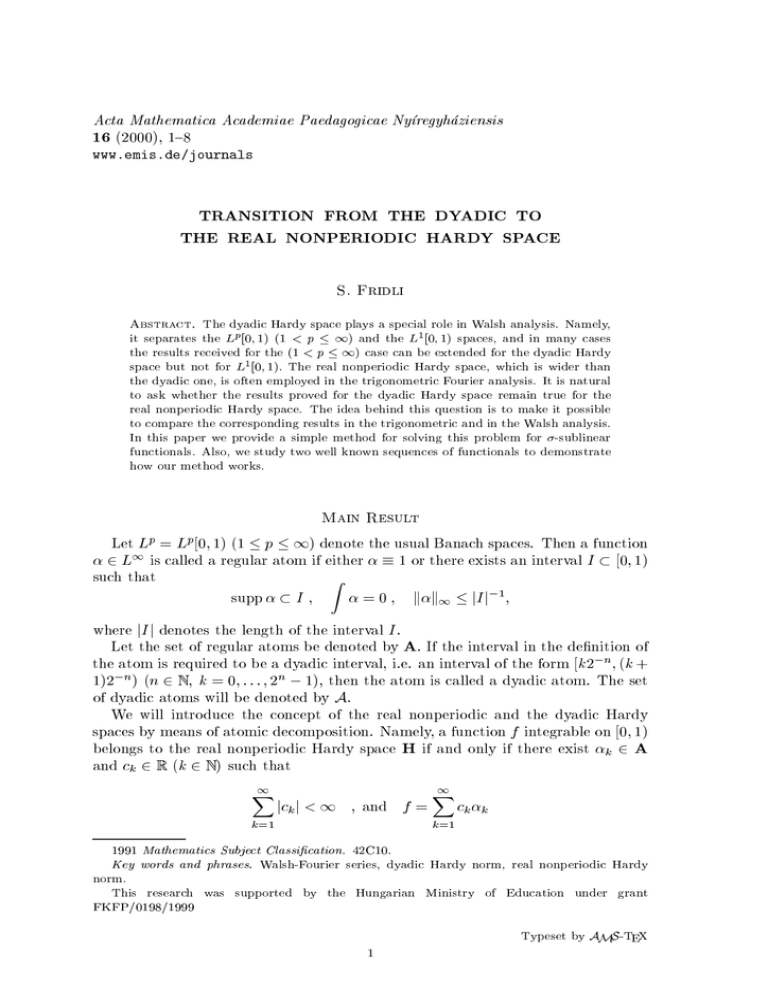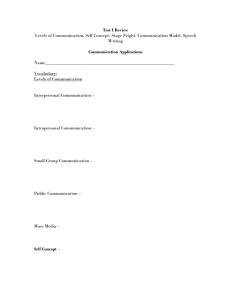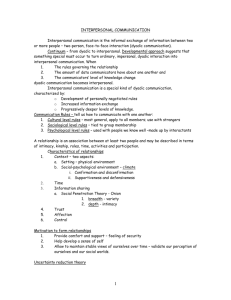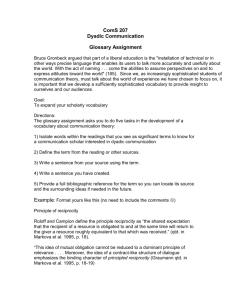16 TRANSITION FROM THE DYADIC TO THE REAL NONPERIODIC HARDY SPACE (2000), 1{8
advertisement

Acta Mathematica Academiae Paedagogicae Nyregyhaziensis
16 (2000), 1{8
www.emis.de/journals
TRANSITION FROM THE DYADIC TO
THE REAL NONPERIODIC HARDY SPACE
S. Fridli
Abstract. The dyadic Hardy space plays a special role in Walsh analysis. Namely,
it separates the Lp [0; 1) (1 < p 1) and the L1 [0; 1) spaces, and in many cases
the results received for the (1 < p 1) case can be extended for the dyadic Hardy
space but not for L1 [0; 1): The real nonperiodic Hardy space, which is wider than
the dyadic one, is often employed in the trigonometric Fourier analysis. It is natural
to ask whether the results proved for the dyadic Hardy space remain true for the
real nonperiodic Hardy space. The idea behind this question is to make it possible
to compare the corresponding results in the trigonometric and in the Walsh analysis.
In this paper we provide a simple method for solving this problem for -sublinear
functionals. Also, we study two well known sequences of functionals to demonstrate
how our method works.
Main Result
Let Lp = Lp [0; 1) (1 p 1) denote the usual Banach spaces. Then a function
2 L1 is called a regular atom if either 1 or there exists an interval I [0; 1)
such that
Z
supp I ;
= 0 ; kk1 jI j,1 ;
where jI j denotes the length of the interval I:
Let the set of regular atoms be denoted by A: If the interval in the denition of
the atom is required to be a dyadic interval, i.e. an interval of the form [k2,n ; (k +
1)2,n ) (n 2 N ; k = 0; : : : ; 2n , 1); then the atom is called a dyadic atom. The set
of dyadic atoms will be denoted by A:
We will introduce the concept of the real nonperiodic and the dyadic Hardy
spaces by means of atomic decomposition. Namely, a function f integrable on [0; 1)
belongs to the real nonperiodic Hardy space H if and only if there exist k 2 A
and ck 2 R (k 2 N ) such that
1
X
k=1
jck j < 1
; and f =
1
X
k=1
ck k
1991 Mathematics Subject Classication. 42C10.
Key words and phrases. Walsh-Fourier series, dyadic Hardy norm, real nonperiodic Hardy
norm.
This research was supported by the Hungarian Ministry of Education under grant
FKFP/0198/1999
1
Typeset by AMS-TEX
2
S. FRIDLI
(the latter equality is understood in the norm of L1), and
kf kH = inf
1
X
k=1
jck j;
where the inmum is taken over all such decompositions.
The dyadic Hardy space H and the corresponding norm are dened in a similar
way, with the only modication that the regular atoms should be replaced by dyadic
atoms. Clearly,
H H L1 ;
and
kf k1 kf kH (f 2 H);
kf kH kf kH (f 2 H):
The following set of step functions will play an important role in our results. Set
= f!k;n : k; n 2 N ; 0 < k < 2n g;
where
2n,1
if (k , 1)2,n x < k2,n
,2n,1 if k2,n x < (k + 1)2,n :
Then !k;n 2 A for any possible n and k but !k;n 62 A if k is even since in this
case the adjacent dyadic intervals [(k , 1)2,n ; k2,n ); [k2,n ; (k + 1)2,n ) do not
form a dyadic interval. The following theorem shows that this is what makes the
dierence between the real nonperiodic and the dyadic Hardy spaces concerning
the boundedness of -sublinear functionals.
The functional F dened on H is called -sublinear if
!k;n (x) =
jF (cf )j = jcjjF (f )j (c 2 R ; f 2 H);
P
and if f = 1
k=1 fk (f; fk 2 H); the convergence is understood in the norm of H;
then
1
X
jF (f )j jF (fk )j:
k=1
Theorem 1. Let F be a -sublinear functional on H; and let F denote its restriction to H: Then F is bounded if and only if it is bounded on and F is bounded.
Moreover
maxfkFk; sup jF (!)jg kFk 4kFk + 2 sup jF (!)j:
!
2
!
Applications
2
In this section we will use Theorem 1 to decide the uniform boundedness of two
sequences of -sublinear functionals. In both of our examples positive results are
known for the dyadic Hardy space. We will show that in one of the examples the
result can be extended to the real nonperiodic Hardy space while in the other it
can not.
TRANSITION FROM THE DYADIC TO THE REAL NONPERIODIC HARDY SPACE 3
In order to formulate our examples we need to introduce some concepts of WalshFourier analysis. For the basic properties of them we refer to [5]. The dyadic
expansion of an x 2 [0; 1) is dened as
x=
1
X
k=0
xk 2,(k+1)
(xk = 0 or 1):
For the so-called dyadic rationals there are two expressions of this form. In this
case we take the one which terminates in 0's.
The concept of dyadic addition (u) and dyadic shift ( ) are dened as follows
1
X
xuy =
k=0
jxk , yk j2,(k+1)
(x; y 2 [0; 1))
f (x) = f (x u )
( 2 [0; 1); x 2 [0; 1); f : [0; 1) 7! R ):
Let rk denote the kth Rademacher function, i.e.
+1
if 0 x < 1=2,
r0 (x) =
,1 if 1=2 x < 1
periodic by 1 , and
(0 x < 1; k 2 N ):
The Walsh functions
can be decomposed into products of Rademacher functions.
P1
Namely, if n = k=0 nk 2k (nk = 0 or 1; n 2 N ) is the binary decomposition of n
then the nth Walsh function in the Paley enumeration is dened as
rk (x) = r0 (2k x)
wn =
1
Y
k=0
rknk :
Then it follows from the denition that
(1)
wj 2n +k = wj 2n wk
(j; n; k 2 N ; 0 k < 2n ):
For any f 2 L1 let f^(k) (k 2 N ) denote its kth
Walsh-Fourier coecient. If the
Pk ,1
Walsh-Dirichlet kernels are denoted by Dk = j=0 wj (k 2 N ) then the WalshFourier partial sums Sk f (k 2 N ) can be calculated as
Sk f (x) =
It is well known (see e.g. [5]) that
1
Z
0
f (t)Dk (x u t) dt:
2n if 0 x < 2,n ;
(2)
D2n (x) =
0 otherwise:
The functionals in our examples are dened as follows
n
1 X
kSk f k1 (f 2 L1 ; n 2 N ; n > 1);
Un f =
log n k=1 k
n
2X
,1
1
,n
n
Tn f = n k
2 k=0 S2 f (k2 )Dk+1 k1
Then the aforementioned result is the following.
(f 2 L1 ; n 2 N ):
4
S. FRIDLI
Theorem 2.
i) There is an f 2 H for which limn!1 Un f = 1:
ii) There exists C > 0 such that Tn (f ) C kf kH (f 2 H; n 2 N ):
Remark 1. Concerning the rst part of Theorem 2 we note that limn!1 Un f =
kf k1 for any f 2 H as it was shown by Simon in [6]. For its generalization
to Vilenkin systems see Gat [3]. On the other hand, Smith proved in [7] that
limn!1 Uen f = kf k1 (f 2 H); where Uen stands for the trigonometric version of Un
(n 2 N ): Our result shows a signicant dierence between the trigonometric and
the Walsh system in this context.
Remark 2. Part ii) of Theorem 2 was proved by Schipp in [4] with the dyadic
Hardy norm on the right side. Here we improve this result by taking the norm of
the real nonperiodic Hardy space. We also note that similar inequality holds for
the trigonometric Dirichlet kernels ([4]). Consequently, the trigonometric and the
Walsh systems behave similarly in this context.
Throughout this paper C will denote an absolute positive constant not necessarily the same in dierent occurrences.
Proofs
Proof of Theorem 1. Let F be bounded on H: Then its restriction F is obviously
bounded, and kFk kF k: Since is a subset of the unit ball of H we have that F
is bounded on ; and sup!2
kF k:
Before proving the other direction we show that for a -sublinear functional F
the boundedness is equivalent to the existence of an absolute positive constant C
such that F () < C holds for each regular atom : The necessity is immediate
by kPkH 1 ( 2 A): On the other hand,Pif F () C for any 2 A; and
1 jc j < 1 then we have by the
f= 1
k=1 ck k with k 2 A (k 2 N ) and
k=1 k
-sublinearity of F that
jF (f )j 1
X
k=1
jck jjF (fk )j C
1
X
k=1
jck j:
Consequently, jF (f )j C kf kH:
Suppose now that F is bounded and sup!2
jF (!)j is nite. Let be a regular
atom dierent from the constant 1 function. RBy denition there exists an interval
I for which supp I; kk1 jI j,1 ; and 01 = 0: If 2,N jI j < 2,N +1 then
there is a K (K 2 N ; 0 < K < 2n ) such that I [(K , 1)2,N ; (K + 1)2,N ]: Set
(
a1 (x) =
,N
R
1
N K2
2 (x) , 2 (K ,1)2,N if (K , 1)2,N x < K 2,N ;
otherwise.
0
,N
Recall that kk1 jI j,1 2N : Therefore (KK2,1)2,N jj 1; and we have that a1
is a dyadic atom. Similarly,
R
(
a2 (x) =
+1)2,N 1 (x) , 2N R (K,N
2
K2
0
if K 2,N x < (K + 1)2,N ;
otherwise
TRANSITION FROM THE DYADIC TO THE REAL NONPERIODIC HARDY SPACE 5
is a dyadic atom. Moreover, it follows from
R (K +1)2,N
= 0: Therefore, if
K 2,N
,N
2N (KK2,1)2,N a0 (x) = 2N R (K +1)2,N >
K 2,N
>
:
0
8
>
>
<
R
R
,N
K2
I = 0 that (K ,1)2,N +
R
if (K , 1)2,N x < K 2,N ;
if K 2,N x < (K + 1)2,N ;
otherwise
then there exists jj 2 such that a0 = !K;N : Thus can be decomposed as
= !K;N + 2a1 + 2a2 :
Hence F () 2 sup!2
jF (!)j + 4kFk ( 2 A): Proof of Theorem 2. For the proof of part i) notice that !2j,1 ;j can be decomposed
as dierence of dyadic shifts of D2j :
1
(j 2 N ):
!2j,1 ;j = (1=2,1=2j D2j , 1=2 D2j )
2
Then
j
2
1X
1 kS j D j , Sk 1=2 D2j k1
U2j !2j,1 ;j =
j
k k 1=2,1=2 2
(j 2 N ):
k=1
It is easy to see that the operators and Sk ( > 0; k 2 N ) can be interchanged.
Indeed,
Sk f (x) =
=
Z
1
0
k
X
`=1
f (t u )Dk (x u t) dt =
1
Z
0
f (t)Dk (x u t u ) dt =
k
X
`=1
f^(`)w` (x u )
f^(`) w` (x)
(f 2 L1; > 0; k 2 N ):
= Sk f (x)
Hence
2j Z 1=2
X
1
1
U2j !2j,1 ;j =
j1=2,1=2j Dk , 1=2Dk j
j
k
0
k=1
+
Since
Z
1
1=2
x0
j1=2,1=2j Dk , 1=2Dk j
j
,1
X
(j; n 2 N ):
1
X
,
(
`+1)
jx` , 1j2
+ x` 2,(`+1)
(1=2 , 1=2 ) u x = 2 +
`=1
`=j
we have that x ! (1=2 , 1=2j ) u x is a one-to-one piecewise linear rearrangement
that maps [0; 1=2) and [1=2; 1) onto themselves respectively. Similarly, x ! 1=2 u x
j
6
S. FRIDLI
maps [0; 1=2) and [1=2; 1) piecewise linearly onto [1=2; 1) and [0; 1=2) respectively.
Consequently,
Z 1
2j 1 Z 1=2
X
1
U2j !2j,1 ;j jDk j , jDk j
j
k
0
k=1
1=2
k
Z 1
j ,1
2 Z 1
X
X
1
1
j 2k+1
jD2k +` j , 2 jD2k +` j
0
1=2
k=0
`=1
(j 2 N ):
The pointwise estimation jDk (x)j 2=x (0 < x < 1; k 2 N ) ([1]) implies
k
j ,1
2 Z1
1X
1 X
jD k j 1 :
j k=0 2k+1 `=1 1=2 2 +`
For the other terms we will use the following inequality (see [1] or [2])
n
1X
kDk k1 C log n
n
(3)
(n 2 N ; n 2):
k=1
By (1) we have D2k +` = D2k + w2k D` : Then (2) and (3) imply that
2k
X
1
Z
0
`=1
jD2k +` j Consequently,
2k
X
Z
1
0
`=1
jD` j , 1 C 2k k:
(j 2 N ):
We proved that the sequence of sublinear functionals Un (n 2 N ) is not uniformly
bounded on H: Then the existence of a function f 2 H with limn!1 Un f = 1
follows from the Banach -Steinhaus theorem.
The proof of ii) will be started by showing
that Tn (n 2 N ) is -sublinear on L1 ;
P1
i.e. on H as well. To this end let f = j=1 fj (f; fj 2 L1 ): By (2) we have
S2n f (x) ,
U2j !2j,1 ;j Cj
X̀
j =1
S2n fj (x)
1 Z
2
f (t) ,
X̀
j
0
f,
n
X̀
j =1
fj (t) D2n (x u t) dt
j =1
f
1
(0 x < 1; ` 2 N ):
P
Consequently, S2n f (x) = 1
j =1 S2n fj (x) (0 x < 1): Then
n
,1 X
1
1 2X
S2n fj (k2,n )Dk+1 Tn f = n 2 k=0 j=1
1
n
1 2X
,1
1
X
X
= 21n S2n fj (k2,n )Dk+1 Tn fj
1 j =1
j =1
k=0
(n 2 N );
TRANSITION FROM THE DYADIC TO THE REAL NONPERIODIC HARDY SPACE 7
i.e. Tn is -sublinear on L1:
It is known ([4]) that there exists C > 0 absolute constant such that Tn f C kf kH (f 2 H; n 2 N ): Therefore, by Theorem 1 we only need to show that the
Tn 's (n 2 N ) are uniformly bounded on :
It is an immediate consequence of the denition of !j;` (j; ` 2 N ; j = 1; : : : ; 2` ,1)
and of (2) that
S2n !j;` =
8
>
<
!k;n
>
:
!j;`
if n < `; and j 2,` = k2,n with some k = 0; : : : ; 2n , 1;
if n < `; and j 2,` =
6 k2,n ; k = 0; : : : ; 2n , 1;
if n `:
0
Therefore, we may suppose that ` n: Then
n,`
n,`
n
(j +1)2
,1
,1
2X
`,1 j 2 X,1
X
2
1
,
n
!j;` (k2 )Dk+1 = n Dk+1 ,
Dk+1 :
Tn !j;` = n 2 k=0
2 k=(j,1)2n,`
1
1
k=j 2n,`
By (1) we have
j 2n,`
X
,1
k=(j ,1)2n,`
Dk+1 = 2 , D(j ,1)2n,` + w(j ,1)2n,`
n `
n,`
2X
k=1
Dk :
Similarly,
n,` ,1
(j +1)2
X
k=j 2n,`
Dk+1 = 2n,` D(j ,1)2n,` + 2n,` w(j ,1)2n,` D2n,` + wj 2n,`
n,`
2X
k=1
Dk :
Then we have by (2) that
n,`
2X
`,1 2
n,`
Tn !j;` = n (w(j ,1)2n,` , wj 2n,` )
Dk , 2 w(j ,1)2n,` D2n,` 2
1
k=1
n,`
2X
`,1 2
n,`
2n 2 + 2 Dk 1 = 12 + 2kK2n,` k1; :
k=1
where Kn = 1=n nk=1 Dk (n 2 N ; n 1) denotes the nth Walsh-Fejer kernel.
Since ([8]) kKn k1 2 for any n we have
P
5
(n; j; ` 2 N ; j = 0; : : : 2` , 1):
2
Consequently, the Tn 's are uniformly bounded on : Tn !j;` References
1. N.J. Fine, On the Walsh functions, Trans. Amer. Math. Soc. 69 (1949), 372{414.
2. S. Fridli and P. Simon, On the Dirichlet kernels and a Hardy space with respect to the Vilenkin
system, Acta Math. Hung. 45(1-2) (1985), 223{234.
8
S. FRIDLI
3. G. Gat, Investigations of certain operators with respect to the Vilenkin system, Acta Math.
Hung. 61 (1-2) (1993), 131{149.
4. F. Schipp, Sidon-type inequalities, Lecture Notes in Pure and Appl. Math. Approx. Theory,
vol. 138, Marcel Dekker, New York-Basel-Hong Kong, 1992, pp. 421-436.
5. F. Schipp, W.R. Wade, P. Simon (with assistance from J.Pal), Walsh series, Adam Hilger,
Bristol, New York, 1990.
6. P. Simon, Strong convergence of certain means with respect to the Walsh-Fourier series, Acta
Math. Acad. Sci. Hungar. 49(3-4) (1987), 425{431.
7. B. Smith, A strong convergence theorem for H 1 (T ), Lecture Notes in Math., vol. 995, Springer,
Berlin-New York, 1983, pp. 169{173.
8. Sh. Yano, Cesaro summability of Walsh-Fourier series, T^ohoku Math. J. 9 (1957), 267{272.
Received November 16, 1999.
Dept. of Numerical Analysis
Eo tvo s L. University
H-1117 Budapest, Pazmany P. setany 1/D
Hungary
E-mail address :
fridli@ludens.elte.hu





